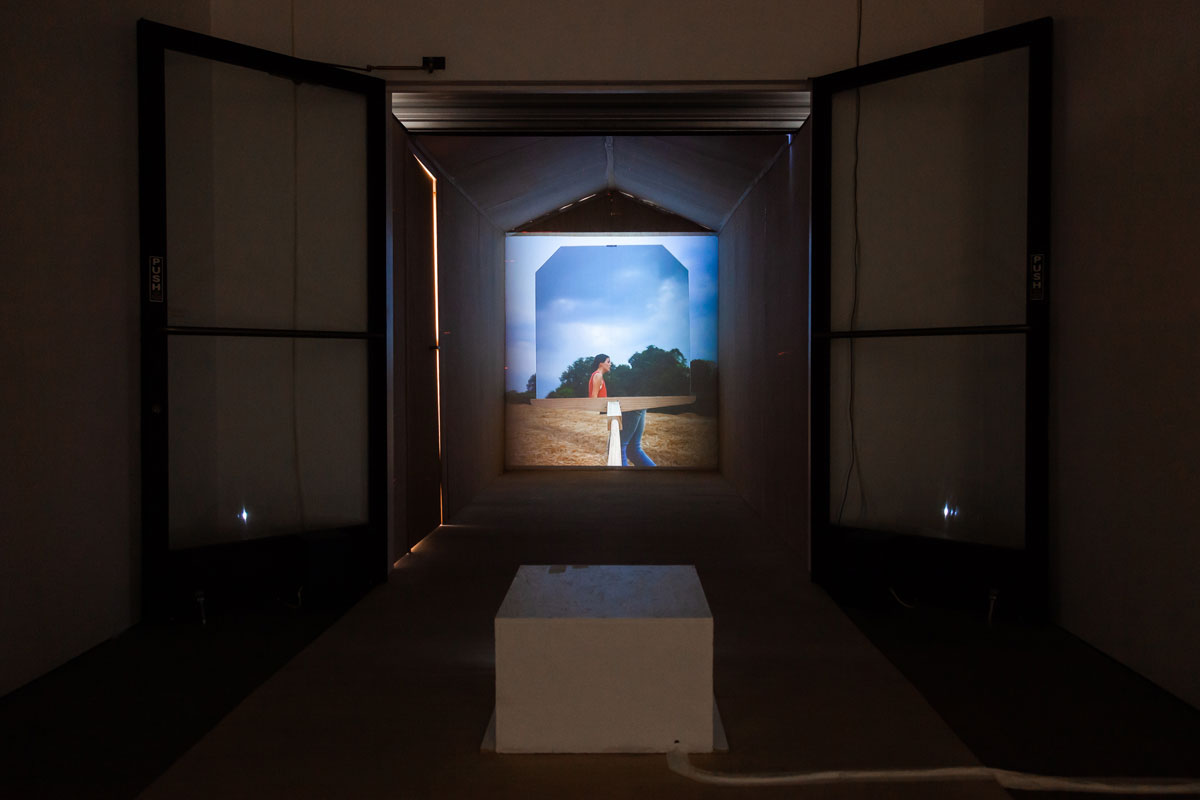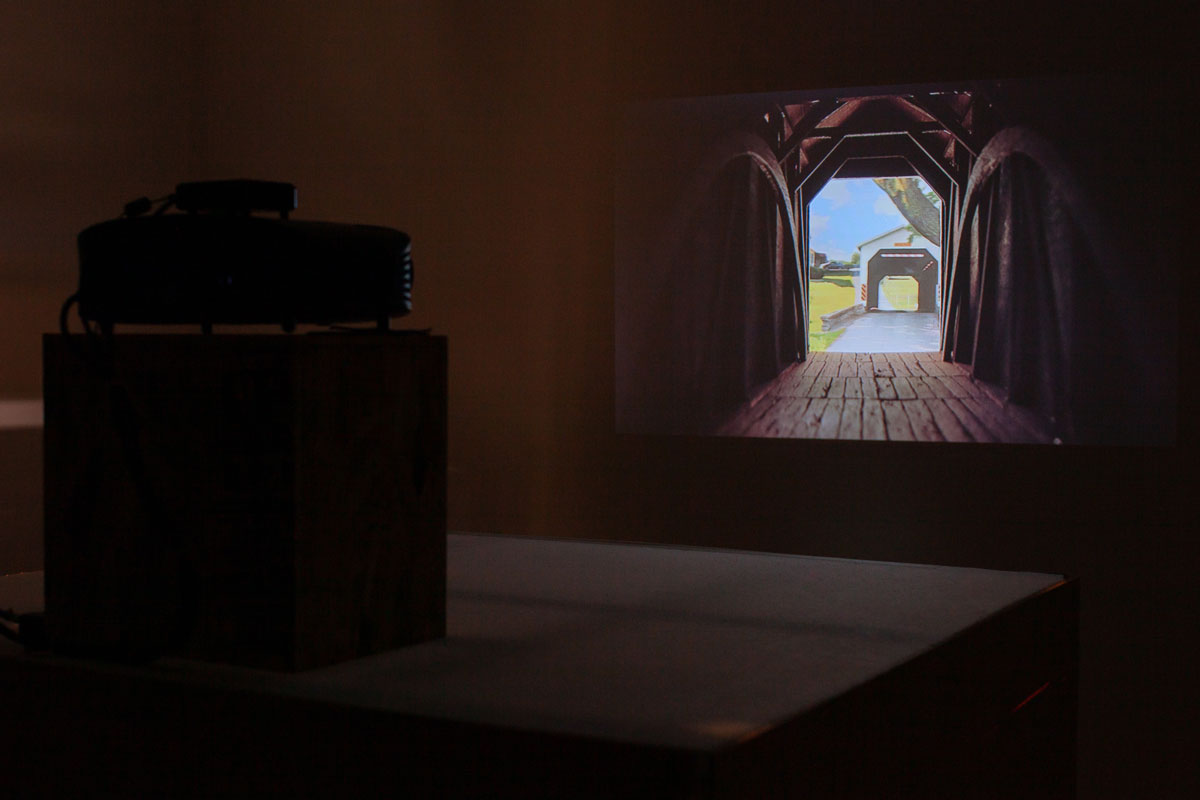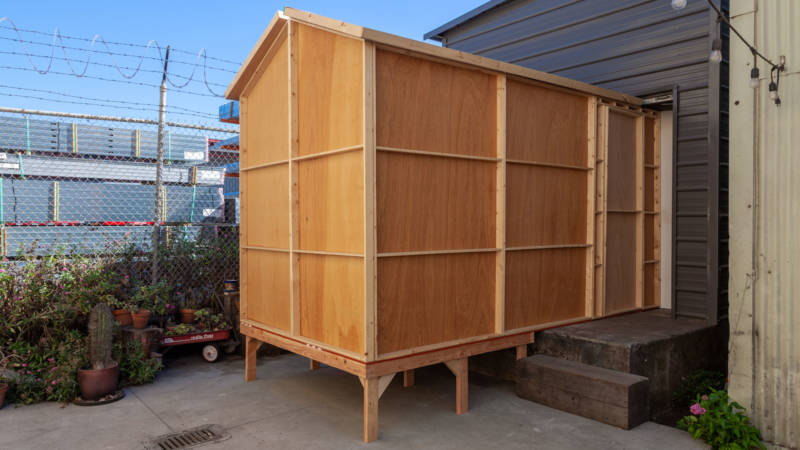The night of Matt Savitsky’s opening at Cloaca Projects, the crowd divided itself into two factions: those who knew the song and those who didn’t know the song.
“Do you know this song?” someone asked me the moment I stepped inside the show—or to be more precise, into a plywood barn-like extension cantilevered out from the project space’s metal facade.
I listened. “No?”
The song, sung in two different keys by a woman seen in two video projections facing each other, plays as a round in a piece titled Crop Circles. But the two overlapping melodies sometimes clash atonally, hauntingly, making it even harder to pin down.
The effect is disorienting, compounded by the video’s visuals: In both projections, the singer walks in a circle in an open field, but she is seen only in the reflection of a rectangular mirror with beveled corners. Someone else’s legs appear walking behind the mirror, and the camera tracks it all. A full explanation of the apparatus that enables this slowly spinning shot isn’t concealed; it’s right there in the show’s takeaway exhibition text, along with the revelation that the singer is Savitsky’s sister, a vocalist and music educator. All the work in The Pleasure Ground was made during a self-created residency in the artist’s hometown of Lancaster, Pennsylvania.

As I wrapped my head around the camera, wooden axle, mirror, and brother-and-sister arrangement that went into making Crop Circles, the song finally clicked.
“Simple Gifts,” a Shaker hymn written in 1848 by Joseph Brackett, is a one-verse song about finding one’s place, gaining true simplicity—and entering “the valley of love and delight.” I learned it as a child, whether at church or school or from my parents, I can’t say; the lyrics are lodged deep. It ends: “To turn, turn will be our delight / Till by turning, turning we come ’round right.”
Deeper inside Cloaca Projects’ now extended space, behind Crop Circles, Savitsy’s second piece also goes round and round, this time silently. Turn Bridge initially looks like a giant cube, roughly constructed of wood, foam board and foam. A small projector sits on top, casting a video onto the back wall of the gallery—this time of a landscape viewed through the tunnel of a covered bridge (the opening a now-familiar shape of a rectangle with beveled corners). The bridge seems to spin, providing a sweeping view of fields, barns, fences and trees.
But why would a bridge turn? I entertained a number of ideas, all of which made some kind of sense to my puzzled brain when I initially viewed the piece from afar. Maybe it’s a bridge suspended over a shipping channel, turning to provide passage (like the 1976 Richard Serra film Railroad Turnbridge referenced in the exhibition text). Maybe it’s a covered bridge in transit—on a flatbed truck—and we’re watching the landscape fly by.

Such speculations are quickly quashed by a thin gap along one side of the cube’s foam top. This strip of light in the otherwise darkened space lets visitors peer into Turn Bridge’s inner workings. If the mechanism of Crop Circles’ making is slightly opaque, and requires some reading (or question-asking) to understand, Turn Bridge is fully transparent. The view through that gap is so delightful, and so mesmerizing, I can’t in good conscience spoil it here. Suffice it to say: something is happening inside the box that reveals the projected video is not a preexisting recording.
All that turning, and the sound of Savitsky’s sister singing with herself, is a bit dizzying in the contained space of The Pleasure Ground. (The title seems to be a reference to a style of English landscaping that emphasizes artistic elements over natural ones.) It fits—there’s plenty of pleasure to be had in Savitsky’s installation, which emphasizes a dreamy, highly personal depiction of Lancaster’s environs over a dispassionate or documentary view. But in addition to pleasure, there’s also the slightly sick feeling that comes from too much of a good thing—like spinning too fast, for too long, until you can’t stand up straight.
Warping sights and sounds, Savitsky creates an installation with its own kind of tunnel vision: a looped and circular memory of a specific place. Inside The Pleasure Ground, Savitsky transfers these memories to Cloaca’s visitors not only through representation, but through vicarious experience. By the end of everyone’s visit, they, too, will know the song.

‘The Pleasure Ground’ is on view at Cloaca Projects (1460 Davidson Ave., San Francisco) through Oct. 26, open Saturdays 1–6pm and by appointment. Details here.


